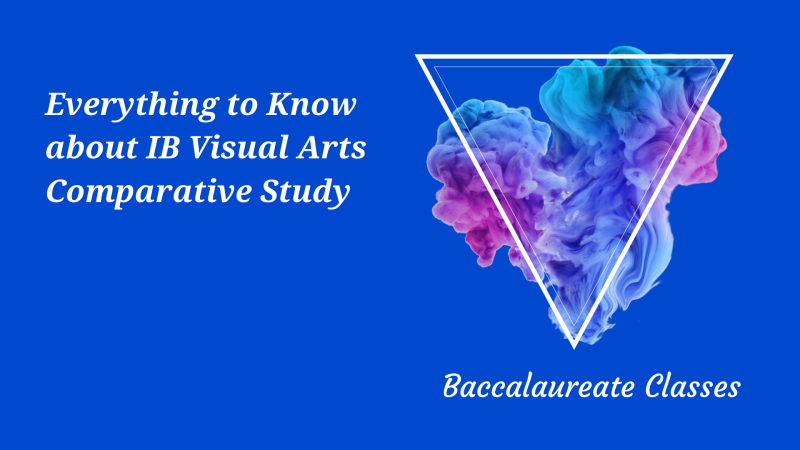OUR BLOG
Everything to Know about IB Visual Arts Comparative Study
Visual Arts is an interesting subject in IB with a lot of scope for exploring, research and developing your very own unique style. However, it is also very tricky to score. From a student and a mentor perspective, this blog will tell you everything you need to take care of to make your CS the very best.
1. KNOW THE CRITERIA
The criteria are very important in a lot of decisions you need to make it your comparative study including what information to include and what not to include. In the vast world of internet, it is often very difficult to filter information you should mention in your CS. Hence, know the criteria. The key features of this theoretical practice include VA in context, VA methods and communicating VA which are all covered by the criteria.
2. SELECTION OF ARTWORKS
Selection of artworks is the most important part because your entire CS depends on it. Try choosing artworks from different centuries, different geographical and cultural locations, different medium and different styles. The obvious question is if everything is different, what do they have in common. Their theme is common. Every artwork has a theme even if not explicitly written on any internet source. Having a common theme gives you a lot of differences and surprising similarities that are interesting to read and analyze, both as a student and an examiner. Explore how the same theme is depicted differently or explored differently by your artists of choice. You IB Visual Arts Tutor can help verify your selection.
3. RESEARCH WELL
Before finalizing your artworks, research well to see if you have enough information to proceed. Once you have selected your pieces on the basis of the previous tip, check if you can find cultural references like art movements or if a particular style that the artist has adopted is unique to a geographical location. For function and purpose, make sure you can find why he made the artwork. Was it a gift? Was it expressive? When you have the answers to main questions like these that the criteria need you to answer, you know that your selection of artworks will work, and you can go in depth later as you work on your CS.
4. FORMAL ANALYSIS
Many students describe their artwork and forget about analyzing it. Analysis in art is very similar to English literature. Literary devices are Elements of Art like line, color, shape, composition etc. and the effect of the literary devices are often one or the other Principals of Design like repetition, emphasis, rhythm etc. As insightful, consistent and in-depth your analysis is, the higher is the quality of your CS. For example, while considering the composition of the painting, look at all aspects of it. Is it a known composition like rule of thirds or triangular composition? It is symmetrical? What kind of balance (symmetrical or asymmetrical) exists? What is the background, mid-ground and foreground and how are they distinguishable? Read IB Visual arts guides, check resources and blogs on the internet and discuss with your IB online tutor to get more ideas about insightful analysis.
5. CULTURAL CONTEXT
Many students get confused whether certain information would go on in a cultural context slide or a function and purpose slide. It is simple. If the information describes a factor that influenced the making of the artwork, it goes into the cultural context slide. Start by answering questions like- where was the artist born or where did he live and how has that influenced his work? Many students make this section very biographical, which is absolutely against what the examiner is looking for. This slide is all about understanding the conscious and subconscious influencing factors in art making. Has the artists’ family influenced his style or his subject? Has any particular event in his life influenced the subject of his artwork? Was he/she a part of an art movement? How is this obvious in the artwork? These are some of the questions you should ask when writing the cultural context slide. Make sure you are considering all aspects of the storyline. The information you present should be insightful, consistent with the artwork and not just the artist and most importantly, must be self-written and not copied from a website.
6. FUNCTION AND PURPOSE
This is where all the meaning of the work, the theme, atmosphere, mood and how they are created goes. How do all these factors help understand why the artist made the artwork? The artist may have made a work for a person as a gift, but the subject and the theme of the painting was his/her choice. So, what is your understanding of the function of the artwork from his/her cultural background and the previously mentioned factors? Answer to this question will help you bring an insightful and informed analysis in your slide. Also, include a little analysis of materials. Was the material or medium chosen unique to the era in which the artwork was made? Why do you think the artist chose the particular medium and how has it helped him/her achieve the function and purpose of the artwork? It is always a good idea to discuss with your IB tutor for further ideas.
7. COMPARISONS
Compare your artworks in terms of formal qualities, cultural context, function and purpose, materials and also in general. Make sure your comparison slides or not repetitive of what you wrote in your other slides but an extension of them. Your writing here should have a sense of continuous comparison, similarities and differences. Consider how these similarities and differences help portray the theme better. If you find difficulty in making these comparisons, then you can take help of an expert via online IB tuition to clarify your doubts.
8. MAKING CONNECTIONS TO OWN ART-MAKING
Have at least 3 of your own artworks that you are connecting to your CS artworks in this section. Make sure you have insightful and informed connections to the CS artworks regarding the choices you make in your own art making. Consider the analysis you have done in the comparisons section and what you learnt from it and show in-depth application in your own art-making. For example, the fact that you are using the same medium as the artist is not a good enough connection. Talk about why the artist used the medium and effect of doing so. Was it appropriate? Do you have the same intention for your artwork and do you wish to have the same effect? Is there a better way to bring out the same effect? Use these questions as references to move ahead.
9. PRESENTATION AND SUBJECT SPECIFIC LANGUAGE
Subject specific language is a given if you use Elements of Art and Principals of Design in your analysis. Other than these, use specific terms for techniques and art movements. Keep in mind to have well balanced slides with both text and visual appearance. If you are explaining triangular composition, use arrows and outline of a triangle on the artwork to show that you are informed of where and what the formal quality is. Your writing at any point should not suggest that you are not informed about the meaning of the term used. Make sure you clarify terms with your Online IB tutors before mentioning them on you study.
These tips are suggestions from a student’s and a teacher’s perspective and should get you on your way to scoring 7 points in your comparative study. Baccalaureate Classes are always there for any extra help or guidance that you may want!

